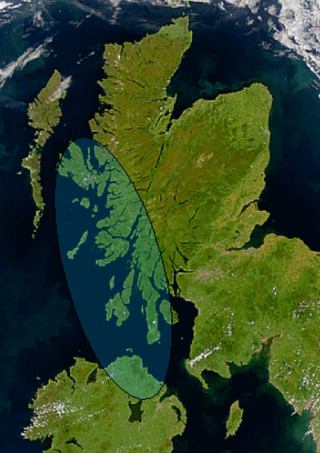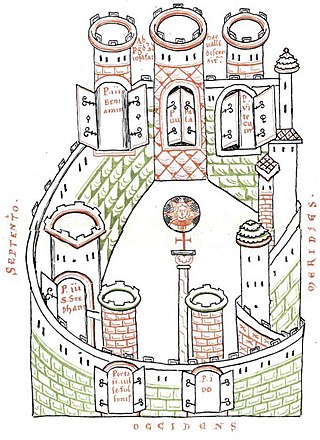
Oswald was King of Northumbria from 634 until his death, and is venerated as a saint, of whom there was a particular cult in the Middle Ages.

Stephen of Ripon was the author of the eighth-century hagiographic text Vita Sancti Wilfrithi. Other names once traditionally attributed to him are Eddius Stephanus or Æddi Stephanus, but these names are no longer preferred or accepted by historians today; modern usage tends to favour "Stephen".

The Holy Lance, also known as the Lance of Longinus, the Spear of Destiny, or the Holy Spear, is alleged to be the lance that pierced the side of Jesus as he hung on the cross during his crucifixion. As with other instruments of the Passion, the lance is only briefly mentioned in the Christian Bible, but later became the subject of extrabiblical traditions in the medieval church. Relics purported to be the lance began to appear as early as the 6th century, originally in Jerusalem. By the Late Middle Ages, relics identified as the spearhead of the Holy Lance had been described throughout Europe. Several of these artifacts are still preserved to this day.

Áedán mac Gabráin, also written as Aedan, was a king of Dál Riata from c. 574 until c. 609 AD. The kingdom of Dál Riata was situated in modern Argyll and Bute, Scotland, and parts of County Antrim, Ireland. Genealogies record that Áedán was a son of Gabrán mac Domangairt.

Mamre, full Hebrew name Elonei Mamre, 'Oaks of Mamre', refers to an ancient religious site originally focused on a single holy tree, growing "since time immemorial" at Hebron in Canaan. At its first location, Khirbet Nimra, a pagan tree cult predated the biblical narrative. It is best known from the biblical story of Abraham and the three visitors. The tree under which he had pitched his tent is known as the oak or terebinth of Mamre. Modern scholars have identified three sites near Hebron which, in different historical periods, have been successively known as Mamre: Khirbet Nimra, Ramat el-Khalil, and Khirbet es-Sibte. The last one contained an old oak tree identified by a relatively new tradition as the Oak of Mamre, which has collapsed in 2019, and is on the grounds of a Russian Orthodox monastery.

Aldfrith was king of Northumbria from 685 until his death. He is described by early writers such as Bede, Alcuin and Stephen of Ripon as a man of great learning. Some of his works and some letters written to him survive. His reign was relatively peaceful, marred only by disputes with Bishop Wilfrid, a major figure in the early Northumbrian church.
Egeria, Etheria, or Aetheria was a Hispano-Roman Christian woman, widely regarded to be the author of a detailed account of a pilgrimage to the Holy Land about 381/2–384. The long letter, dubbed Peregrinatio or Itinerarium Egeriae, is addressed to a circle of women at home. Historical details it contains set the journey in the early 380s, making it the earliest of its kind. It survives in fragmentary form in a later copy—lacking a title, date and attribution.

Church of the Sepulchre of Saint Mary, also Tomb of the Virgin Mary or the Church of the Assumption, is a Christian church built around an ancient Jewish rock-cut tomb in the Kidron Valley – at the foot of Mount of Olives, in Jerusalem – believed by Eastern Christians to be the burial place of Mary, the mother of Jesus. The Status Quo, a 250-year old understanding between religious communities, applies to the site.
Adomnán or Adamnán of Iona, also known as Eunan, was an abbot of Iona Abbey (r. 679–704), hagiographer, statesman, canon jurist, and saint. He was the author of the Life of Columba, probably written between 697 and 700. This biography is by far the most important surviving work written in early-medieval Scotland, and is a vital source for our knowledge of the Picts, and an insight into the life of Iona and the early-medieval Gaelic monk.

The Palestine Pilgrims' Text Society (PPTS) was a text publication society based in London, which specialised in publishing editions and translations of medieval texts relevant to the history of pilgrimage to the Holy Land. Particular attention was given to accounts by pilgrims and other travellers containing geographical or topographical information, as well as those which discussed the manners and customs of the Holy Land. The original narratives were written in a variety of languages, including Greek, Latin, Arabic, Hebrew, Old French, Russian, and German.
De locis sanctis was composed by the Irish monk Adomnán, a copy being presented to King Aldfrith of Northumbria in 698. It was based on an account by the Frankish monk Arculf of his travels to the Holy Land, from which Adomnán, with aid from some further sources, was able to produce a descriptive work in three books, dealing with Jerusalem, Bethlehem, and other places in Palestine, and briefly with Alexandria and Constantinople. It aimed to give a faithful account of what Arculf actually saw during his journey. Many of the manuscripts contain the second earliest known map of Jerusalem

The Vita Sancti Wilfrithi or Life of St Wilfrid is an early 8th-century hagiographic text recounting the life of the Northumbrian bishop, Wilfrid. Although a hagiography, it has few miracles, while its main concerns are with the politics of the Northumbrian church and the history of the monasteries of Ripon and Hexham. It is one of a collection of historical sources from the late 7th- and early 8th-centuries, along with the anonymous Vita Sancti Cuthberti, the works of Bede and Adomnán's Vita Sancti Columbae, that detail the Christianisation of Great Britain and make the period the best documented period in English history before the age of Alfred the Great.

John of Würzburg was a German priest who made a pilgrimage to the Holy Land in the 1160s and wrote a book describing the Christian holy places, the Descriptio terrae sanctae.
The Libellus de locis sanctis is a 12th-century Latin guide book and travelogue of Palestine designed for the use of Christian pilgrims to the Holy Places. It "stands out" from the mass of medieval guide books "for its literary and informative qualities".

The Arculf Map of Jerusalem is an ancient ground plan map of the city of Jerusalem which was published in manuscripts of the first book of De Locis Sanctis by Arculf via Adomnán, dated to 680 CE. Not all the known manuscripts of the text include the maps and plans. The earliest known manuscript showing the map dates from the ninth century, two centuries after Arculf's journey.

Rorgo Fretellus, also spelled Fetellus, was a Frankish priest in the Kingdom of Jerusalem who wrote a widely circulated description in Latin of the Christian holy places in the Holy Land, the Descriptio de locis sanctis.
Meletios the Younger (c. 1035 – c. 1105), also called Meletios of Myoupolis, was a Byzantine Greek monk, pilgrim and priest. He is venerated as a saint in Eastern Orthodoxy and his feast is celebrated on 1 September.
Historical sources of the Crusades: pilgrimages and exploration include those authors whose work describes pilgrimages to the Holy Land and other explorations to the Middle East and Asia that are relevant to Crusader history. In his seminal article in the Catholic Encyclopedia, Dominican friar and historian Bede Jarrett (1881–1934) wrote on the subject of Pilgrimage and identified that the "Crusades also naturally arose out of the idea of pilgrimages." This was reinforced by the Reverend Florentine Stanislaus Bechtel in his article Itineraria in the same encyclopedia. Pilgrims, missionaries, and other travelers to the Holy Land have documented their experiences through accounts of travel and even guides of sites to visit. Many of these have been recognized by historians, for example, the travels of ibn Jubayr and Marco Polo. Some of the more important travel accounts are listed here. Many of these are also of relevance to the study of historical geography and some can be found in the publications of the Palestine Pilgrims' Text Society (PPTS) and Corpus Scriptorum Eccesiasticorum Latinorum (CSEL), particularly CSEL 39, Itinerarium Hierosolymitana. Much of this information is from the seminal work of 19th-century scholars including Edward Robinson, Titus Tobler and Reinhold Röhricht. Recently, the Independent Crusaders Project has been initiated by the Fordham University Center for Medieval Studies providing a database of Crusaders who traveled to the Holy Land independent of military expeditions.

The Breviary of Jerusalem is a short late antique Latin guidebook for Christian pilgrims to Jerusalem.











